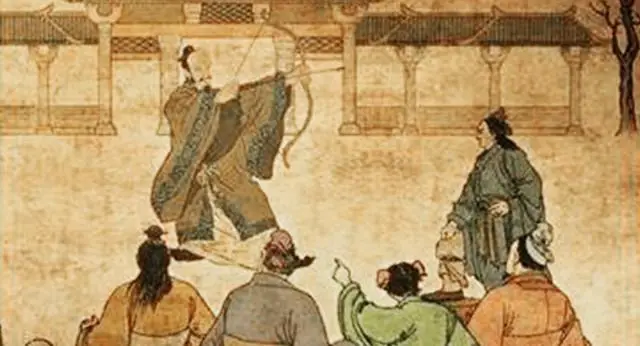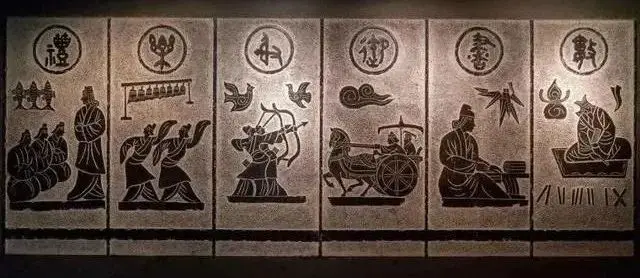The “Six Arts” refer to six essential skills within the aristocratic education system of ancient China, particularly during the Zhou Dynasty. These skills are:礼 (Lǐ) – Rituals, 乐 (Yuè) – Music and Dance, 射 (Shè) – Archery, 御 (Yù) – Charioteering, 书 (Shū) – Calligraphy, and 数 (Shù) – Mathematics. The aristocratic education system of the Zhou Dynasty, which began in 1046 BCE, mandated that students master these six fundamental abilities.
Derived from the “Rites of Zhou – Offices of Earth and Education – The Protector of the Heir Apparent,” the quote states: “Educate the sons of the state in the Tao. Teach them the six arts: firstly, the Five Rites; secondly, the Six Music; thirdly, the Five Archery; fourthly, the Five Charioteering; fifthly, the Six Calligraphy; and sixthly, the Nine Numerals.” This represents the concept of “integrating the Five Classics with the Six Arts.”
What is Six Arts?
The Six Arts, known as “Liu Yi” in Chinese, were fundamental skills required for students in ancient China, particularly emphasized within the Confucian educational system. The Six Arts encompassed various disciplines aimed at cultivating well-rounded individuals, including:
礼 (Lǐ) – Rituals and Rites:
Definition: Moral standards and behavioral norms.
Significance: Emphasized proper conduct, manners, and ethical behavior.
乐 (Yuè) – Music and Dance:
Definition: Artistic forms such as music, dance, and other aesthetic expressions.
Significance: Focused on cultivating an appreciation for the arts and aesthetics.
射 (Shè) – Archery:
Definition: Skill in archery, representing martial prowess.
Significance: Emphasized military training and precision in the use of weaponry.
御 (Yù) – Charioteering:
Definition: Skill in charioteering and horsemanship.
Significance: Highlighted proficiency in handling chariots and horses, essential in ancient warfare.
书 (Shū) – Calligraphy:
Definition: Ability to read and write.
Significance: Focused on literacy and mastery of the written language, including calligraphic skills.
数 (Shù) – Mathematics:
Definition: Numerical and mathematical skills.
Significance: Included proficiency in arithmetic and mathematical concepts.
The origin of the Six Arts can be traced back to the educational system of the Zhou Dynasty, specifically within the aristocratic class. The purpose was to foster comprehensive qualities and abilities in the education of noble youths. Throughout ancient China, the Six Arts played a crucial role in both private and official education.

As time progressed, the Six Arts evolved into more specific and practical educational content. For instance, the “Zhou Li” (Rites of Zhou) outlined specific requirements and standards for the Six Arts. Various dynasties produced writings and theories regarding the education of the Six Arts. The influence of Six Arts education persisted until the end of the Qing Dynasty when it gradually gave way to modern school systems.
Beyond education, the Six Arts found broad applications in various societal domains, including politics, military affairs, and culture. In politics, rituals and music were integral to the political system, while archery and charioteering skills held importance in military training. In cultural contexts, calligraphy and mathematics served as crucial means of cultural transmission, and artistic expressions like music and dance played significant roles in cultural exchanges.
Ancient Six Arts
【礼】: Ritual. The Five Rites are auspicious rites, funeral rites, military rites, diplomatic rites, and festive rites. Illustrated by Confucius lecturing.
【乐】: Music. The Six Music refers to the six sets of music and dance in Yunmen, Xianchi, Dashao, Daxia, Dahuo, and Dawu. The earliest ceremonial dance was “Yunmen Da Juan.” In the time of Yao, there was “Xianchi.” In the time of Shun, there was “Dashao.” Confucius claimed to have heard the Shao music, greatly admired it, and called it perfect. In the time of Yu, there was “Daxia.” In the Shang Dynasty, there was “Dahuo.” In the Zhou Dynasty, there was “Dawu.” “Yunmen Da Juan” was used to sacrifice the heavenly gods; “Xianchi” was used to sacrifice the earth gods; “Dashao” was used to sacrifice the four directions; “Daxia” was used to sacrifice mountains and rivers; “Dahuo” was used to sacrifice Jiang Yuan, the founder of the Zhou Dynasty; “Dawu” was used to sacrifice the ancestors of the Zhou Dynasty. The Six Music was passed down to the Qin and Han dynasties, but only “Dashao” and “Dawu” remained.
【射】: Archery. Military archery techniques include white arrows, successive connection, quick shooting, retreating a foot when shooting with the king, and four arrows in a row hitting the target.
【御】: Charioteering. Driving and controlling horse-drawn and chariots. The Five Charioteering includes responding to the call of the phoenix, pursuing water curves, passing the king’s platform, dancing at intersections, and pursuing birds on the left.
【书】: Calligraphy. The Six Scripts (although not explicitly explained in the Zhou ritual, later speculation suggests) include pictograms, ideograms, compounds, phonetic loans, transfers, and phonetic loans. (Note: Transfers and phonetic loans are methods of reading characters, while pictograms, ideograms, compounds, and phonetic loans are methods of constructing characters, with phonetic loans accounting for about ninety percent.)
【数】: Mathematics. The art of calculation or arithmetic. Illustrated by “The Nine Chapters on the Mathematical Art.”
【Related Records】In “Records of the Grand Historian” by Sima Qian, he wrote, “Those who cultivate themselves take the Six Arts as their standard.
Modern interpretation
【礼】: “Li” refers to ritual. Without learning ritual, one cannot establish oneself. As stated in the “Book of Master Guan” from the “Guanzi,” “With granaries full, one knows ritual; with sufficient clothing and food, one understands honor and disgrace.” In ancient times, there were officials in charge of ritual and music for various occasions such as weddings, funerals, entrance ceremonies, apprenticeship ceremonies, and sacrifices (司礼). Confucius himself held positions related to ritual and was exposed to it from a young age. He engaged in playful activities with ritual objects, presenting himself with proper ceremonial decorum (as recorded in the “Records of the Historian – House of Confucius”). In the context of state ceremonies and sacrifices at ancestral temples, ancient official offices such as the Taichang Temple and the Sacrificial Office were established. There were officials responsible for reading prayers, praising ceremonies, and managing ceremonial affairs. In modern times, government agencies like the Protocol Department of the Ministry of Foreign Affairs handle national ceremonies and diplomatic etiquette. In the hospitality sector, hotels have a Chief Concierge position responsible for managing hospitality-related affairs. The formal qualification for a Chief Concierge is certified by the international organization Les Clefs d’Or.

【乐】: “Yue” refers to music. If there is ritual, there must be joyous music for celebrations. The Five Tones (五音), Gong, Shang, Jue, Zhi, and Yu, accompanied these joyous occasions. In ancient times, there were government officials dedicated to overseeing music and managing the musical arrangements for ceremonies and celebrations. Historical records mention that Confucius had three main teachers, and among them, Chang Hong taught him music. In Tang Dynasty, there was an elaborate system for managing music with various departments such as Jiaoshe (郊社), Tayue (太乐), Guchui (鼓吹), Taiyi (太医), Taibu (太卜), and Linxi (廪牺). In the Ming Dynasty, the Ministry of Rites was established, and within it, there were positions such as Qing (卿), Shaoqing (少卿), Cheng (丞), Dianbu (典簿), Xielv Lang (协律郎), Boshi (博士), and Zanli Lang (赞礼郎). In modern times, music has developed into a cultural industry.
【射】: “She” refers to archery, one of the ancient Six Arts. Confucius mentioned in the “Analects” that a gentleman, while not engaging in conflict, must practice archery. Archery is not only a military skill for defending the country but also a sport for self-cultivation and physical fitness. Ancient Chinese archery included both arrow shooting and slingshot usage, and during the Spring and Autumn period, the crossbow was invented. The importance of archery is evidenced by the discovery of stone arrowheads dating back 28,000 years in the Zhiyu cultural site in Shanxi province. In the Tang Dynasty, Empress Wu Zetian established a military examination system, where archery skills were crucial. Modern archery includes not only traditional archery and slingshots but also modern firearms such as pistols and rifles.
【御】: “Yu” refers to charioteering, the skill of driving. In both ancient and modern contexts, “yu” encompasses both the skill of driving vehicles and the broader field of leadership, management, and governance. Historical examples include the story of King Zhao Xiang learning charioteering from his son, and the famous horse race strategy of Tian Ji. The art of charioteering is not merely about physical combat but also about strategic thinking, making it a comprehensive discipline that involves governance and leadership.
【书】: “Shu” refers to calligraphy. The “Book of Han” first mentions the specific names of the “Six Scripts,” stating, “In ancient times, at the age of eight, one entered elementary school, and therefore, the Zhou official Bao Shi was in charge of the national school, teaching the Six Scripts: pictographs, ideographs, compound ideographs, phonetic loan characters, transferred characters, and borrowed characters. These are the foundations of writing.” Calligraphy encompasses the art of writing, character recognition, and composition.
【数】: “Shu” refers to numbers, mathematics. In modern times, it has extended to the broader concept of mathematical and scientific principles. Ancient Chinese mathematics became well-developed with the appearance of the “Nine Chapters on the Mathematical Art” during the Han Dynasty. Ancient mathematicians attributed the origin of mathematics to the “I Ching” and the “He Tu” and “Lo Shu” diagrams. The “number” in the context of the Six Arts should refer to the understanding of natural and humanistic changes, essentially the “changing variables.”
Reference:
“What do the Six Arts refer to? What inspiration do the Six Arts have for education?” QuFu88 [Retrieved on March 22, 2016].